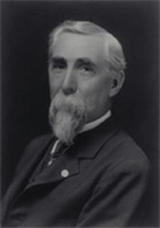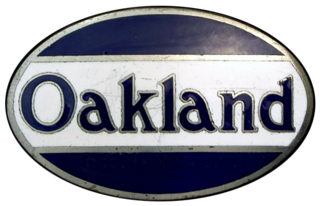
Buick is a division of the American automobile manufacturer General Motors (GM). Started by automotive pioneer David Dunbar Buick in 1899, it was among the first American automobile brands and was the company that established General Motors in 1908. Before the establishment of General Motors, GM founder William C. Durant had served as Buick's general manager and major investor. With the demise of Oldsmobile in 2004, Buick became the oldest surviving American carmaker.

Oldsmobile was a brand of American automobiles, produced for most of its existence by General Motors. Originally established as "Olds Motor Vehicle Company" by Ransom E. Olds in 1897, it produced over 35 million vehicles, including at least 14 million built at its Lansing, Michigan factory alone.

Lincoln Motor Company, or simply Lincoln, is the luxury vehicle division of American automobile manufacturer Ford Motor Company. Marketed among the top luxury vehicle brands in the United States, Lincoln is positioned closely against its General Motors counterpart Cadillac. However, beginning with the 2021 model year, they only offer SUV and crossover vehicles.

Cadillac Motor Car Division, or simply Cadillac, is a division of the American automobile manufacturer General Motors (GM) that designs and builds luxury vehicles. Its major markets are the United States, Canada and China. Cadillac models are distributed in 34 additional markets worldwide. Historically, Cadillac automobiles were at the top of the luxury field within the United States, but have been outsold by European luxury brands including BMW and Mercedes since the 2000s. In 2019, Cadillac sold 390,458 vehicles worldwide, a record for the brand.

The E-M-F Company was an early American automobile manufacturer that produced automobiles from 1909 to 1912. The name E-M-F was gleaned from the initials of the three company founders: Barney Everitt, William Metzger, and Walter Flanders.

Henry Martyn Leland was an American machinist, inventor, engineer, and automotive entrepreneur. He founded the two premier American luxury automotive marques, Cadillac and Lincoln.
The Aerocar is an American automobile that was built from 1906 until 1908 in Detroit, Michigan. Backed by Henry Ford's former partner, coal merchant Alexander Malcomson, the short-lived company offered an air-cooled four-cylinder luxury car which sold for $2,800.

The Ford Piquette Avenue Plant is a former factory located within the Milwaukee Junction area of Detroit, Michigan, in the United States. Built in 1904, it was the second center of automobile production for the Ford Motor Company, after the Ford Mack Avenue Plant. At the Piquette Avenue Plant, the company created and first produced the Ford Model T, the car credited with initiating the mass use of automobiles in the United States. Prior to the Model T, several other car models were assembled at the factory. Early experiments using a moving assembly line to make cars were also conducted there. It was also the first factory where more than 100 cars were assembled in one day. While it was headquartered at the Piquette Avenue Plant, Ford Motor Company became the biggest U.S.-based automaker, and it would remain so until the mid-1920s. The factory was used by the company until 1910, when its car production activity was relocated to the new, bigger Highland Park Ford Plant.

Durant Motors Inc. was established in 1921 by former General Motors CEO William "Billy" Durant following his termination by the GM board of directors and the New York bankers who financed GM.

The Oakland Motor Car Company of Pontiac, Michigan, was an American automobile manufacturer and division of General Motors. Purchased by General Motors in 1909, the company continued to produce modestly priced automobiles until 1931 when the brand was dropped in favor of the division's Pontiac make.

Fisher Body was an automobile coachbuilder founded by the Fisher brothers in 1908 in Detroit, Michigan.

The first Cadillac automobiles were the 1903 Model built in the last quarter of 1902. These were 2-seater "horseless carriages" powered by a reliable and sturdy 10 hp (7 kW) single-cylinder engine developed by Alanson Partridge Brush and built by Leland and Faulconer Manufacturing Company of Detroit, of which Henry Leland was founder, vice-president and general manager.
Detroit Assembly was a General Motors automobile factory in Detroit, Michigan on Clark Street, south of Michigan Avenue. It began operations in 1921 and Cadillac bodies were supplied by Fleetwood Metal Body in 1921 after Fisher Body assumed operations. It was the second location that built Cadillacs, when Cadillac originally started out as the Henry Ford Company which was located at the intersection of Cass Avenue and Amsterdam Street. Engine block and cylinder heads were cast at Saginaw Metal Casting Operations then assembled at Tonawanda Engine before delivery to Detroit Assembly for installation.

In the late 1920s, American automotive company General Motors (GM) launched four companion makes to supplement its existing lineup of five-passenger car brands, or makes. The companion makes were LaSalle, introduced for the 1927 model year to supplement Cadillac; Marquette, introduced in 1929 for 1930 to supplement Buick; Pontiac, introduced for 1926 to supplement Oakland; and Viking, introduced for 1929 to supplement Oldsmobile. GM's fifth existing brand, Chevrolet, did not receive a companion make. With the exception of Viking, each of the companion makes were slotted below their "parent make" in GM's pricing hierarchy.
The Detroit Automobile Company (DAC) was an early American automobile manufacturer founded on August 5, 1899, in Detroit, Michigan. It was the first venture of its kind in Detroit. Automotive mechanic Henry Ford attracted the financial backing of twelve investors; Detroit Mayor William Maybury, William H. Murphy and others. As with many early car ventures, the company floundered, and it was dissolved in January 1901. Twenty vehicles were built and $86,000 of investment was lost.

Marquette was an American automobile manufacturer established by General Motors in 1909 after the purchase of the Rainier Motor Car Company. The Marquette Company did not last long and in 1912 GM announced the company would be closed.

William Ernest Metzger was an automotive pioneer and salesman from Detroit. He opened one of the first automobile dealerships in the United States, and participated in the early development of a number of early automobile companies, including the Cadillac Automobile Company and the E-M-F Company, in which the "M" stands for his name.

The Lincoln Motor Company Plant was an automotive plant at 6200 West Warren Avenue in Detroit, Michigan, later known as the Detroit Edison Warren Service Center. The complex was designated a National Historic Landmark in 1978, due to its historic association with World War I Liberty engines and the Lincoln Motor Company. However, the main structures were demolished in 2003 and NHL designation was withdrawn in 2005.
The automotive industry in Massachusetts refers to a period of time from 1893 to 1989 when automobiles were manufactured in the Commonwealth of Massachusetts commercially. In the early years, the state produced more automobiles than Detroit, Michigan. During the 20th century, General Motors and the Ford Motor Company were producing automobiles at the Framingham Assembly and Cambridge Assembly, respectively.

The Ford Mack Avenue Plant, a rented wagon manufacturing shop in Detroit, Michigan, was the first facility used by the Ford Motor Company to assemble automobiles. Henry Ford began to occupy it in April 1903 in preparation for the company's incorporation, which occurred on June 16, 1903. Production of the original Ford Model A began that same month after the incorporation. Soon after, the building was expanded and a second story was added to increase production. The Model A was followed by the Model AC, which was a Model A with the larger Ford Model C engine. Most of the major car components were manufactured by outside companies, including the "running gear", which was supplied by the Dodge Brothers Company. A total of 1,708 cars were assembled at the Mack Avenue Plant. The company occupied the building until October 1904, when its manufacturing operations were moved to the Ford Piquette Avenue Plant in Detroit, where the Ford Model T would later be built.

















